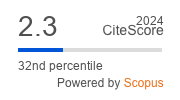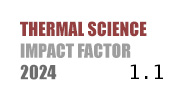THERMAL SCIENCE
International Scientific Journal
,
,
,
,
,
,
,
,
,
,
PREPARATION AND EXPERIMENTAL STUDY OF AQUEOUS SIMULATED LUNAR SOIL IN LUNAR POLAR REGION
ABSTRACT
The polar region of the Moon has great scientific value and research significance because of abundant mineral resources, possible water and ice and unique geographical location resources, and is becoming a new hot spot in the new round of international lunar exploration. China's Chang ‘e-7 probe will also go to the polar region of the Moon carry out the sampling and detection mission of water-bearing lunar soil. In this paper, a set of water-bearing simulated lunar soil preparation system in polar regions is proposed, and the preparation and research of water-bearing simulated lunar soil in polar regions are carried out from several aspects, such as preparation of water-bearing simulated lunar soil, research and development of vacuum system, design of simulated lunar soil bucket and vacuum test. The test results show that the water-bearing simulated lunar soil developed by the system has no abnormal situation in vacuum environment, and can be applied to the subsequent ground test of Chang ‘e-7 detector
KEYWORDS
PAPER SUBMITTED: 2024-11-24
PAPER REVISED: 2024-11-30
PAPER ACCEPTED: 2024-12-11
PUBLISHED ONLINE: 2025-06-01
THERMAL SCIENCE YEAR
2025, VOLUME
29, ISSUE
Issue 2, PAGES [1251 - 1257]
- Wu, W., et al., China Lunar Exploration Program, Journal of Deep Space Exploration, 6 (2019), 5, pp. 405-416
- Barnes, J., et al., An Asteroid Alice Deposition in Polar Cold Traps, Icarus, 215 (2011), 1, pp. 1-16
- Stewart, B. D., et al., Simulations of a Comet Impact on the Moon and Associated Ice Deposition in Polar Cold Traps, Icarus, 215 (2011), 1, pp. 1-16
- Vattuone L., et al., Accretion Disc Origin of the Earth's Water, Philosophical Transactions, Series A, Mathematical, Physical, and Engineering Sciences, 371 (2013), 1994, 20110585
- Qian, Y. Q., et al., China's Chang'e-5 Landing Site: Geology, Stratigraphy, and Provenance of Materials, Earth and Planetary Science Letters, 561 (2021), 116855
- Xie, M., et al., The Provenance of Regolith at The Chang 'e-5 Candidate Landing Region, Geophys. Res. Planets, 125 (2020), 5, e2019J E006112
- Zeng, X. G., et al., Landing Site of The Chang'e-6 Lunar Far Side Sample Return Mission, Nature Astronomy, 7 (2023), July, pp. 1188-1197
- Zheng, Y. H., et al., Analysis of Chang'e-5 Lunar Core Drilling Process, Chinese Journal of Aeronautics, 36 (2023), 2, pp. 292-303
- Yong, P., et al., Influence of Lunar Regolith Compressibility on Sampling Performance of Thick Wall Spiral Drills, Chinese Journal of Aeronautics, 36 (2023), 2, pp. 50-362
- Greenwood, J. P., et al, Water in Apollo Rock Samples and the D/H of Lunar Apatite, Lunar and Planetary Science Conference, 1553 (2010), 2439
- Ma, R. Q., et al., Design and Validation of In-situ Rapid Predictive Sensor for Lunar Soil Water Content, Thermal Environment of Lunar Surface, 10 (2022), pp. 1399-1409
- Lawrence, D. J., A Tale of Two Poles: The Presence, Distribution, and Origin of Volatiles at the Polar Regions of the Moon and Mercury, Journal of Geophysical Research: Planets, 122 (2017), 1, pp. 21-52
- Vasavada, A. R., et al., Near-Surface Temperatures on Mercury and the Moon and the Stability of Polar Ice Deposits, Icarus, 144 (1999), 2, pp. 179-193
- Rubanenko, L., et al., Thick Ice Deposits in Shallow Simple Craters on the Moon and Mercury, Nature Geoscience, 12 (2019), 8, pp. 597-601
- Butler, B. J., et al., The Migration of Volatiles on the Surfaces of Mercury and the Moon, Journal of Geophysical Research: Planets Journal of Geophysical Research, Planets, 102 (1997), E8, pp. 19283-19291

